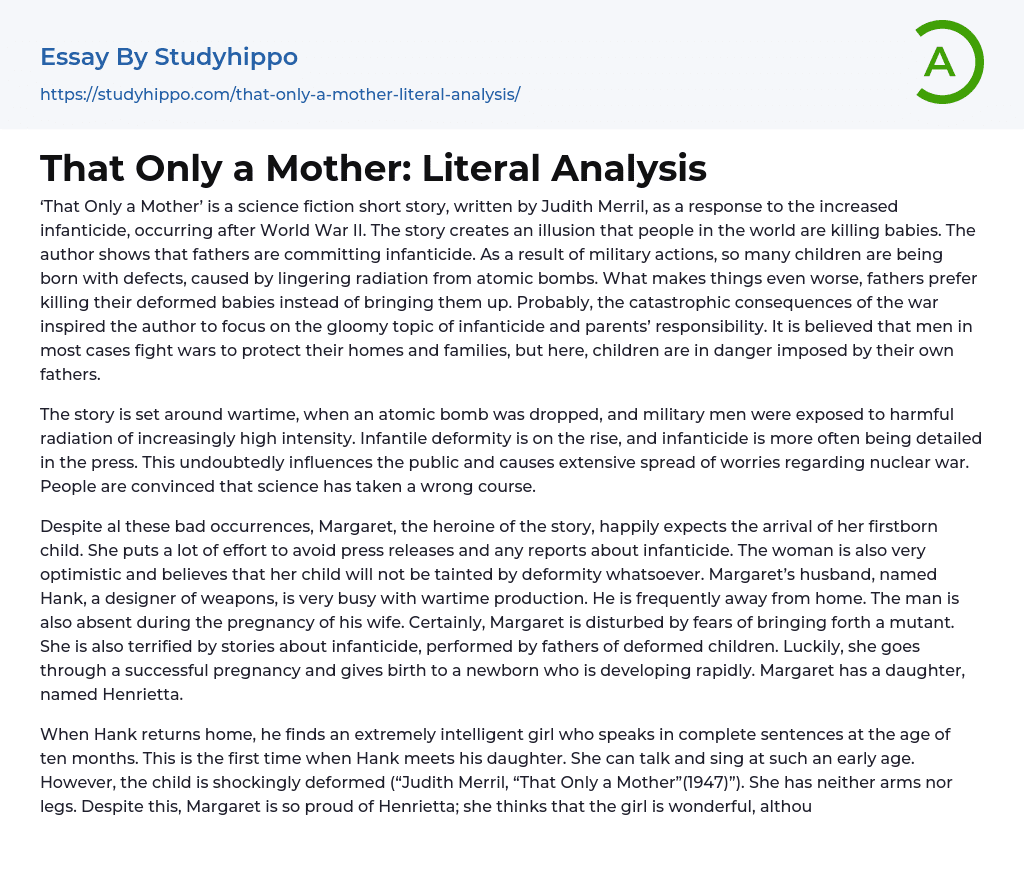‘That Only a Mother’ is a science fiction short story, written by Judith Merril, as a response to the increased infanticide, occurring after World War II. The story creates an illusion that people in the world are killing babies. The author shows that fathers are committing infanticide. As a result of military actions, so many children are being born with defects, caused by lingering radiation from atomic bombs. What makes things even worse, fathers prefer killing their deformed babies instead of bringing them up. Probably, the catastrophic consequences of the war inspired the author to focus on the gloomy topic of infanticide and parents’ responsibility. It is believed that men in most cases fight wars to protect their homes and families, but here, children are in danger imposed by their own fathers.
The story is set around wa
...rtime, when an atomic bomb was dropped, and military men were exposed to harmful radiation of increasingly high intensity. Infantile deformity is on the rise, and infanticide is more often being detailed in the press. This undoubtedly influences the public and causes extensive spread of worries regarding nuclear war. People are convinced that science has taken a wrong course.
Despite al these bad occurrences, Margaret, the heroine of the story, happily expects the arrival of her firstborn child. She puts a lot of effort to avoid press releases and any reports about infanticide. The woman is also very optimistic and believes that her child will not be tainted by deformity whatsoever. Margaret’s husband, named Hank, a designer of weapons, is very busy with wartime production. He is frequently away from home. The man is also absent during th
pregnancy of his wife. Certainly, Margaret is disturbed by fears of bringing forth a mutant. She is also terrified by stories about infanticide, performed by fathers of deformed children. Luckily, she goes through a successful pregnancy and gives birth to a newborn who is developing rapidly. Margaret has a daughter, named Henrietta.
When Hank returns home, he finds an extremely intelligent girl who speaks in complete sentences at the age of ten months. This is the first time when Hank meets his daughter. She can talk and sing at such an early age. However, the child is shockingly deformed (“Judith Merril, “That Only a Mother”(1947)”). She has neither arms nor legs. Despite this, Margaret is so proud of Henrietta; she thinks that the girl is wonderful, although, there is an offhand remark that nurses cann hardly say whether the child is a male or a female. Nevertheless, Margaret cannot see her girl as a mutant but only as a brilliant young person. For her, the girl is a child prodigy. On the other hand, Hank realizes that Henrietta is deformed. Contrary to Margaret’s bright perspectives, Hank views the child as a wormlike creature. His wife disagrees strongly; she is in a deep denial that the girl is a monster. Consequently, Hank takes the child and strangles her to death.
This story brings a clear opposition between men and women in the domestic sphere through the multiple perspectives on Margaret and Hank. Men produce the weapons that affect their children. Moreover, instead of protecting their offspring, they kill them. As opposed to men, mothers view these children as normal human beings who deserve care and love. They, therefore,
embrace them, because ‘that only a mother’ loves. Further, it is the responsibility of fathers to protect the family. This responsibility has been left to women. The story shows that fruits of a nuclear war destroy the nuclear family. The influence of the weaponry is everywhere; nobody can avoid it. In addition to that, people demolish the good beginning in their souls and turn into real monsters that kill their own children.
- World War I essays
- World War Ii essays
- Atomic Bomb essays
- American Civil War essays
- Attack essays
- Cold War essays
- Crimean War essays
- Emilio Aguinaldo essays
- Iraq War essays
- Korean War essays
- Nazism essays
- Nuclear Weapon essays
- Philippine Revolution essays
- Trench Warfare essays
- Vietnam War essays
- Western Front essays
- Diplomacy essays
- Emperor essays
- Rwanda essays
- Tribe essays
- Revolutionary War essays
- War of 1812 essays
- Mexican American War essays
- Hitler essays
- The Spanish American War essays
- League Of Nations essays
- Battle Of The Somme essays
- Treaty Of Versailles essays
- Fascism essays
- D-day essays
- Atomic Physics essays
- Atomic Bombings Of Hiroshima And Nagasaki essays
- Electron essays
- Child essays
- Child labor essays
- Childcare essays
- Adoption essays
- Aunt essays
- Babies essays
- Bedroom essays
- Caring essays
- Children essays
- Daughter essays
- Divorce essays
- Dog essays
- Dysfunctional Family essays
- Family Tradition essays
- Family Values essays
- Father essays
- Foster Care essays




